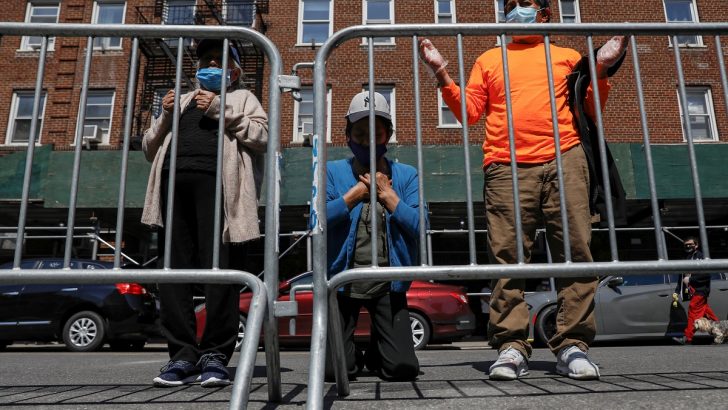As the journey back to common worship continues, parishes will need to be ready to hit the ground running, writes Michael Kelly
Archbishop Diarmuid Martin spoke for many when he said on Monday evening that “as Christians, we suffer through not being able to celebrate our faith through public worship”.
The suspension of public Masses in mid-March as the coronavirus reached these shores has caused a lot of pain and untold spiritual, emotional and mental damage.
The archbishop added that “there is a sense in which this void is especially experienced by priests.
“Priests share in the anxiousness of all believers and in addition they find themselves unable to carry out to the full what is most essential in their calling,” he said following a meeting of the bishops’ conference standing committee considering a return to public Masses.
What is clear is that there can be no return to common worship unless parishes take proactive steps and are ready to hit the ground running when State restrictions ease.
‘New normal’
A draft of the Framework Document for a Return to the Public Celebration of Mass and the Sacraments and the Pastoral Life of the Church obtained by The Irish Catholic sets out protocols that will have to be followed to ensure that a return to Mass is as safe as possible. This included encouraging older and vulnerable parishioners to continue to remain at home and follow the Mass via a webcam or on the radio. Choirs and congregational singing will also not feature in the ‘new normal’ for the Church.
The document notes that “we must be particularly aware of priests, ministers and Faithful who are particularly vulnerable to Covid-19 infection, but who also risk the damaging effects of physical and social isolation.
“If properly implemented and carefully managed, these measures will help all of us to re-engage with the public life of the Church with confidence, energy and joy,” the draft says.
Some of the main provisions in the 88-point document include:
-Preparing for a return to public sacramental life is not something that priests can or should attempt to do on their own. Instead, they should work with the parish council and identify people with suitable expertise (medical, health and safety, project management, crowd control, etc.) to implement a plan.
-Competent parishioners who have the personal skills to act as stewards should be identified.
-A risk assessment should be carried out to ensure churches can be made ready.
-In a parish which has a number of churches, it is recommended to consider if it is better to open only the larger church initially.
-Holy Water fonts will remain empty.
-Hand sanitisation stations will become standard as will signage directing social distancing and churches will now have a designated entry and exit door.
-Where practicable, outdoor Masses will be part of the future.
When it comes to a return to public Masses, the number of available benches will determine roughly the maximum number in the church for any Mass. The number of available places will be publicly displayed at the entrance.
Parishes are encouraged to manage public expectations so that it is not necessary to turn people away. This will include reminding people that the obligation to attend Sunday Mass is dispensed and arranging in advance to spread participation in Mass across the week.
Parishes will also be asked to suggest to those who are vulnerable due to old age or ill-health, that they might continue to participate on webcam or on radio for the moment and, if they wish, arrange for a family member to bring them Holy Communion, while observing the required sanitising of hands etc.
Missalettes, shared prayer books, hymnals or hymn sheets should not be available. There will also be boxes at the back of the church to avoid the need for people to pass collection baskets or bags.
Cantor
The draft proposes that churches should endeavour to have an organist and cantor to provide music but there should be no choir or congregational singing. Priests are asked not to wear masks or gloves, but should simply remain at the required physical distance from the congregation during the entirety of the Mass and the sign of peace will not involve physical contact.
Holy Communion will be distributed in the hand only for the foreseeable future and other options for Communion under consideration include a Perspex screen, with an opening at hand level being placed at all Communion distribution points. Alternatively, each priest will wear a transparent visor following the correct protocols.
People will be asked to approach Holy Communion in single file and consideration will also be given to distributing Holy Communion to people in their seats with priests wearing transparent visors making their way through the Church.
It doesn’t suggest that there will be a return to any kind of normal life for the thousands of cocooned people”
Thought is also being given to the possibility of loudspeakers outside to allow people unable to enter the church to gather at a safe distance in carparks with the possibility of Holy Communion being brought out to them. Parishioners will also be advised to leave Mass gradually and not to congregate together outside afterwards.
When it comes to Confession, the document states that it “must be celebrated while respecting both the required physical distance and the integrity of the sacrament”.
“For the foreseeable future it will not be possible to safely celebrate the sacrament in the normal way in the confessional. This is not just about protecting the priest from the virus, it is also about protecting the faithful from the virus that a priest may, without knowing it, be carrying,” it says.
The plan is that provision would be made in the body of the church for a confessional area this would include a waiting area which provides both for the confidentiality of the celebration and for the required physical distance of those waiting.
Our biggest challenge may be lack of motivation to do all that is required on the part of some…”
When it comes to the sacraments of initiation, the document says that the celebration of Confirmation for children who have finished their time in primary school should be given priority. It says that the most helpful solution, balancing pastoral need and timely celebration, would see the celebration of Confirmation in each parish by the parish priest.
Conscious of demographics, the document notes that the State roadmap envisages some relaxation of the cocoon, but “it doesn’t suggest that there will be a return to any kind of normal life for the thousands of people who are currently cocooned, many of whom make a huge contribution in the parish community and among whom are counted many of our priests.
“We recognise that many elderly lay ministers and other volunteers, as well as priests, may be experiencing anxiety and a real sense of loss both because of Covid-19 and because of the experience of cocooning and may question whether they can or should return to public ministry under the present circumstances,” the document says.
Getting back to some semblance of normality is a huge task and the bishops point out that “it is clear that re-opening the pastoral life of the Church will be far more challenging institutionally than anything we have been through in the past few months.
“Our biggest challenge may be lack of motivation to do all that is required on the part of some, and unbridled enthusiasm to do everything on the part of others,” according to the document.
The bottom line is, as the bishops point out, that churches “will only be able to reopen for public liturgy when the proper procedures have been put in place”.
Any Catholic with an interest in a return to Mass will have to play their part – parishes will need an army of volunteers.


 Michael Kelly
Michael Kelly People in the Queens borough of New York City pray at St Bartholomew Church during the coronavirus
pandemic.
Photo: CNS
People in the Queens borough of New York City pray at St Bartholomew Church during the coronavirus
pandemic.
Photo: CNS 